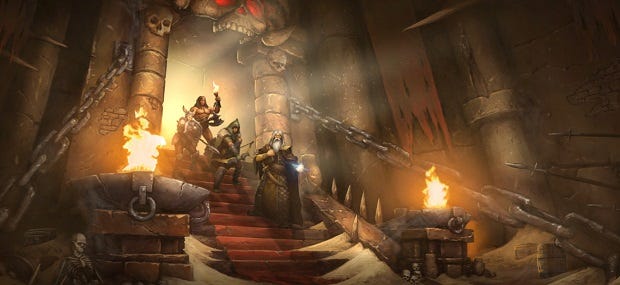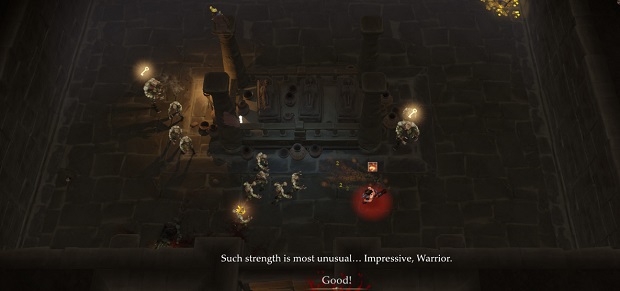Wot I Think: Gauntlet
Food fight
Gauntlet has always been a simple pleasure. Run through a dungeon with up to three pals, killing hundreds of monsters as a team, nicking treasure from one another like arch rivals, and shooting the food a split second before your wounded wizard chum manages to grab it. Arrowhead, of Magicka fame, have taken the reigns for this latest installment of the veteran series. Here's wot I think.
I was tempted to write an entire review in the form of a roundtable discussion between the heroes from the original game but I couldn't decide if Merlin, the wizard, was going to be a condescending smartarse or a confused old duffer. I should have just settled on 'confused old duffer' since an elf called Questor couldn't be anything other than a condescending smartarse.
Let the record show that the height of my wit would have been to portray Thor the warrior as a monsyllabic slab of muscle. Instead of all that nonsense, you'll find analysis of the game below, but first, the answers to some questions that you might well have.
1) You can play solo but it's not a particlarly enjoyable experience. The game's greatest pleasure is in the odd balance between cooperating and competing - working together to herd and eliminate monsters, while making use of each others' strengths, but descending into mischief when robbing treasure, health or potions from former allies.
2) There's around four or five hours of content, but there isn't even enough variety for that length of playtime. Throughout the dungeons, few gimmicks are introduced and if you're not having a good time in the first half hour, you probably won't be in the final half hour. However, if you're having fun for the first five hours, you might well fancy running through again on a higher difficulty level or as a different class.
3) You can play locally or online. I've seen reports of problems with the netcode and have had quite a few dropped connections myself, but I've also managed to play for three hours at a time without any problems, lag or otherwise. The netcode ain't perfect though.
4) The Grim Reaper makes regular appearances and is a dick.
Here are the gritty details.
Before I started playing Arrowhead's new take on the fast-paced co-op dungeon crawler, Gauntlet, I tensed my brain in an effort to remember elements of the original games. And, yes, I played the first two and they were...fast-paced co-op fantasy dungeon crawlers. A valkyrie, an elf, a warrior and a wizard - generators that pumped out enemies until they were destroyed. Something else...
A weird implementation of melee combat, where enemies lost health when they came into contact with the player, but sapped the player's health at the same time. That led to agonising situations when a friend was surrounded by skellywobbles, the herd pulsing occasionally as one evaporated during the assault. The two-way draining of health instilled the mass of monsters with a crushing claustrophobic quality, and there were horrid ghosts as well, which vanished on impact, taking a chunk of the player's life force with them. And how do we restore life force? We eat the food.
And that's why nobody should shoot the food. Gauntlet's place in the collective consciousness is about that voice and the ominous and slightly regretful tone in which it informed players that one of their number had indeed shot the food.
I don't know if Gauntlet has a furious fanbase, ready to defend misuse of its lore and style, but if it weren't possible to shoot the food, Arrowhead's game wouldn't be worthy of the name.
Food is available in the dungeons of the new Gauntlet, in the familiar form of roasted poultry dinners laid out on silver serving trays. While people do shoot it on occasion, they're just as capable of burning it to a crisp, pulverising it with an axe, or skewering it with a pointy spear. Arrowhead have included lots of callbacks and fine detail from the earlier games, but the biggest change from the original formula is in the various methods of destroying food and other items.
Each of the four heroes now has a unique set of moves, rather than simply a different sprite for their projectiles. There's also equipment to purchase, most notably in relics which consume a potion on use and have various effects, from summoning a gargoyle companion to dropping a monster-magnet bomb into the dungeon.
As might be expected, the warrior is the least interesting but possibly the most important to have as the foundation of a party. To go along with his basic attack, he has a powerful precise cleave that requires a satisfying precision and a spinning mob-mashing move with a cooldown period. He can also sprint through enemies, ramming them to the ground, a move which is charged by pushing the right stick (I played with a 360 pad and preferred it to the mouse/keyboard controls, although they seem fine).
Even the warrior's moves allow for crowd control, thanks to the charge and the spin attack, and he's not entirely dull to play around with. He's also the best character to use in solo play, simply because he's comfortable when surrounded by enemies. The Valkyrie works as well, thanks to a shield that is used directionally (right thumbstick again) and can block almost any attack, but she's better as a second line unit, behind the warrior.
The elf is an archer and the character I've got along with the least. Attacks seem underpowered, partly because they require a greater degree of accuracy, which I often lack in the thick of the action. I've never found myself alongside a particularly useful elf when playing online, so the problem isn't limited to my cackhandedness, but I suspect people who master the bow will be vital on higher difficulty levels.
Last up is the wizard, a simplified version of the mages that made Arrowhead's name. Like the protagonists of the Magicka games, wizards in Gauntlet combine elements to make spells, although there are only a handful to discover and the results are functional rather than farcical. Arrowhead's humour has filtered through into the game and there's a likeable Discworldian Cohen the Barbarian vibe to the adventures.
Food is in. Differentiation between classes is in. There are hordes of monsters as well, steaming out of generators that need a good pasting before they explode into bits. The melee system is gone though, which makes sense given that every character has a basic close range attack. Very few attacks kill player characters in one hit but health bars are fragile little things and becoming cornered leads to doom.
In solo, the game has a very simple flow. Stay out of enemy range, dodging projectiles, and pick away at the crowd, concentrating attacks on any generators in the room before tackling the remaining beasties. There's little variation in the levels, which either have the Grim Reaper chasing the party throughout or don't. There are boss battles but they're about destroying monsters and monster generators while another threat is in the room rather than a complete change of pace.
The dungeons are a series of arena-like rooms rather than mazes with puzzling sections, and that's where the greatest deviation from the source material is apparent. Gauntlet and its first sequel were built around co-op play that relied on level design for much of its tension and amusement. Arrowhead's Gauntlet leans on the skills and combat styles of its four protagonists rather than on the design of its levels.
Put simply, the original Gauntlet was a game about controlling spaces and the creatures within those spaces - a herding game - while this Gauntlet is a game about cooperative combat. Enemies are still controlled in clusters but the difference between choosing how to kill them rather than where to kill them is a huge change.
That may well be familiar to anyone who has played Seven Sorrows or Dark Legacy, but from its chiptune menu music to its constant visual references, Arrowhead's intepretation is certainly looking right back to the arcades and the start of the series. With a party of four, it's an enjoyable diversion and the four classes are well balanced and complementary, but the traps, layouts and enemies aren't quite disruptive enough, and even on higher difficulties the routine of combat tests endurance rather than creative solutions.
Gauntlet is available now.















